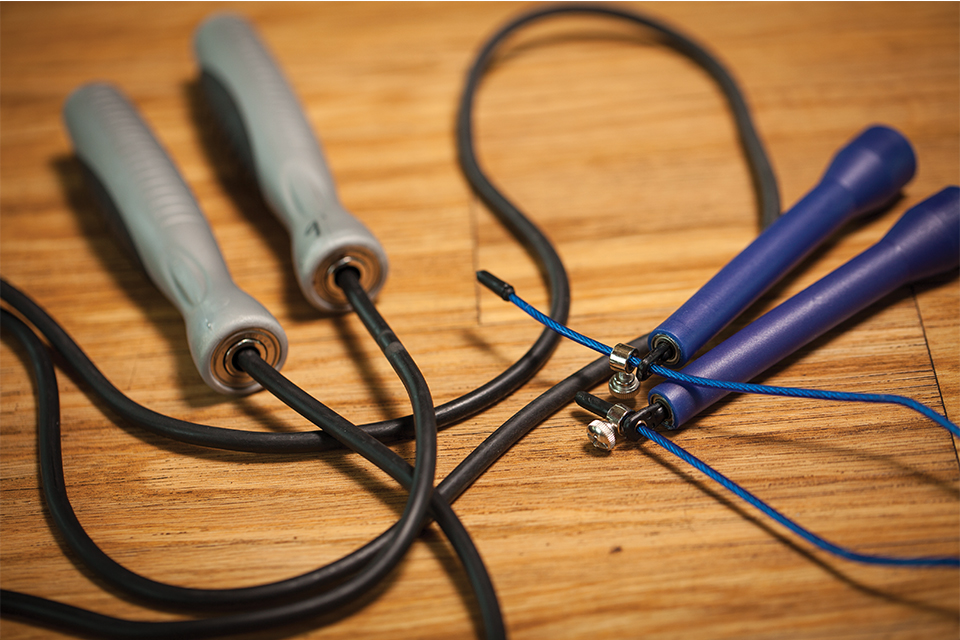Gym Equipment Review: Jump Ropes, Floor Gliders, and Rip Deck

With the holidays approaching at full speed, I know first-hand how often workout frequency takes a hit. Even the most dedicated among us has a hard time fitting in regular training with all of the other holiday commitments.
Somewhere between traveling to see friends and family and attending numerous social gatherings full of delicious foods, you’ll face a recipe for disaster if you don’t keep your activity level consistent.
I love the holidays just as much as the next person, but the aftermath can be a bit depressing if you’re not careful. The last thing anyone wants to see in January when confronting all those holiday bills is an extra 15 pounds, too!
I’ve selected a few items of equipment to review (one here and the other two online) to show some convenient options that can help keep excessive, unwanted body fluff at bay. While at first glance, these items may seem a bit retro or even obsolete, I assure you they pack that much-needed metabolic punch.
Cue “Gonna Fly Now” and get your egg yolks ready; it’s time for a training throwback. I can’t seem to grab a jump rope without having flashes of those Rocky training scenes popping into my head.
Jumping rope, a vintage form of exercise that dates back to 1600 A.D., requires a bit of skill, rhythm, and patience to fully appreciate. While heavily targeting agility, coordination, and endurance, training with a jump rope takes some time to effectively master. However, all ages and fitness levels can easily add a jump rope to their workout routines.
Training-style jump ropes are made from different materials than the standard kids’ toy made popular in the 1940s and ’50s. They range from leather to wire, and two of the more notable styles of jump ropes are the weighted rope and speed rope. The conventional weighted rope starts at less than a pound and can reach as much as five pounds, with the heavier options geared to target strength and muscular endurance. The lighter speed rope aims to keep users on their toes with its combination of agility and cardiovascular endurance demands.
You may be asking, “But how do I figure out which rope is the right one for me?” What are your goals? If you are looking to work on upper body strength and add some conditioning to your program, I suggest a weighted rope. If your interest is in increasing cardiovascular output with more emphasis on agility and quickness, then a speed rope will best suit your needs.
One common feature of all types of jump ropes is their effectiveness in weight loss and general conditioning programs. The great cardiovascular demands of jumping rope allow you to get (or stay) in very good shape with little space and time required. Many experts firmly believe that jumping rope for just 10 minutes with little to no rest is equivalent to running an 8-minute mile. The convenience makes it worth so much more than the few dollars spent purchasing a jump rope. This invaluable fitness tool can take you a long way with a fraction of the requirements most cardio equipment needs.
Every person will find his or her preference of rope at some point or another, so I recommend practicing over and over again until you find the right fit. You may also discover that certain ropes work better for you according to the particular workout. I prefer weighted ropes during my warm-ups to give my body that jolt of energy leading into my workout. I also prefer the weighted rope during resistance circuit rotations to help keep my heart rate elevated. This form of exercise also plays in well to the current trend of high intensity interval training (HIIT), which is why I look to the speed rope for a challenge in quickness and coordination during my higher intensity sessions. The speed rope is a fixture in my metabolic conditioning circuits since it is so effective and easy to transition to while I circulate through rounds.
CrossFit has recently re-introduced double-unders, a technique in jump roping, which has created a demand for wired speed ropes.
Double-unders require an advanced skill set and a lot of practice, much like most power movements in CrossFit. Working on mastering them is a fun way to kick your jump rope sets into high gear while ramping up your metabolism tenfold.
Again, you will find the rope that best suits you by taking the time to try them out. Whether using the weighted rope for an easier pace or a speed rope to blaze through double-unders, you will find a challenge that’s appropriate. So with the Rocky theme song playing in the background, I challenge you to mix in a bit of jump rope to your workouts.
Exercise Caution:
I recommend easing into this activity if you have serious knee, back, or shoulder issues. It would not hurt to initially simulate the movement pattern of jumping rope without a rope to see how your body handles the workload.
Tips for Getting Started Jumping Rope
-Select a standard, weighted rope.
-Adjust the rope by holding the handles and stepping in the center of the rope.
-Shorten the rope so the handles reach your armpits.
-Wear properly fitted athletic shoes, preferably cross-trainers.
-Hold both handles in one hand and swing the rope to develop a feel for the rhythm.
-Next, without using the rope, practice jumping.
-Now, put the two together—try jumping continuously for 1 minute. The more you begin to incorporate this technique into your workout, the longer you’ll be able to jump.






